IMEHA (International Model Equine Hobbyists Association) was an online photo showing site that existing until 2018. Included on the site were these guidebooks for judging and showing model horses in Performance classes. MEPSA has obtained permission to share the info contained in the guides.
Riding Patterns :: Point Deducts :: Tack :: Rider :: Reins :: Set-Up Options :: Photo Examples
Based on the rules from NRCHA
There is no cross entering of entries for Cutting or Reining using the same photo.
Three Classes Offered
Reined Cowhorse – HERD WORK
Reined Cowhorse – COW WORK
Reined Cowhorse – REINED WORK
The REINED COWHORSE EVENT consists of three parts in which the contestant must compete. The event is judged on both working of a cow (sometimes referred to as wet work) and a reining pattern (dry work). Failure of an exhibitor to attempt to complete the herd work, the fence work portion of cow work, and reined work portions of the event will result in the exhibitor not being considered an entry in the event and not being eligible for points or placing. An entry which attempts to complete the cow work and has not been disqualified will be scored accordingly at the judge’s discretion. And entry going off pattern in the rein work will receive a score of zero. The fall of a horse and rider being judged shall be cause for disqualification and not eligible to be placed.
The scoring system is based on 60-80 points. Half-points may be used. The contestant is judged from the time that he/she enters the arena until he/she completes the pattern. The lowest score possible is 60 points and the highest score possible is 80. The average score for a typical work is 70 points.
Horses are judged on performance only.
For IMEHA, entries are possible in one, two or all three parts of the Reined Cowhorse event. The model horse is not required to compete in all three parts (classes) of the event.
Reined Cowhorse – HERD WORK
The HERD WORK portion of the Reined Cowhorse event is similar to cutting.
Judging will begin at the time line.
The contestant shall approach the herd with no hesitation, weaving or reluctance on the part of the horse to enter the herd sufficiently deep enough to show his ability to make a cut. The horse shall work quietly, but alertly, causing very little disturbance to the herd or the animal brought out. Credit will be given for driving cattle, clearing the herd by a sufficient distance and setting up cow while holding it in a working position as near the center of the arena as possible. The degree of difficulty, eye appeal and the amount of courage in staying on a tough cow will be taken into consideration. The amount of time actually spent working cattle in the 2 1/2 minute period will have a positive effect on the total score. The horse should show a great deal of expression but no ill will toward the animal. Judging will end at the whistle.
Rider may hold horn while working cow.
SCORING the Reined Cowhorse — HERD WORK class:
1 point penalties:
A. (Miss) Loss of working advantage.
B. Noise directed by contestant toward cattle.
C. Working out of position.
D. Toe, foot, or stirrup on horse’s shoulder.
3 point penalties:
A. Hot quit.
B. Cattle picked up/running into or scattering herd.
C. Failure to make a deep cut.
D. Back fence (each time the back fence actually stops or turns the animal being worked).
5 point penalties:
A. Horse quitting a cow (Definition: When the horse refuses to stop or turn around with the cow).
B. Losing a cow.
C. Changing cattle after a specific commitment.
D. Failure to separate a single animal after leaving the herd.
E. Blatant disobedience, defined as kicking, biting, bucking, rearing, striking, or obviously insubordinate.
F. Spurring or hitting in front of the cinch at anytime.
-0- Zero score:
A. Horse turns tail.
B. Using two hands on the reins in a bridle (Definition: If the hand holding the romal touches the closed part of the reins, it is considered two hands on the reins).
C. Fingers between the reins in a bridle.
D. Illegal equipment.
E. Leaving working area before time expires.
G. Bloody mouth (inside).
NOTE: A judge may blow his/her whistle at anytime to terminate the work. A score of zero will be given if the work is not complete at that time.
Reined Cowhorse – COW WORK
The COW WORK portion of the Reined Cowhorse event requires three displays of control: (An entry into the Reined Cowhorse – COW WORK class may depict any of these three activities.)
1. BOX the cow at the end of the arena
2. Work the cow along the FENCE
3. Take the cow to the center of the arena and CIRCLE the animal at least once in each direction.
Judging begins when the contestant enters the arena.
When the cow work is judged the exhibitor receives their cow in the arena and holds the cow at the prescribed end of the arena for a sufficent time to demostrate the ability of the horse to contain the cow. After a reasonable time the exhibitor takes the cow down the fence, making at least one turn each way on the fence. Then the contestant shall take the cow to the center of the arena and circle the animal at least once in each direction.
Rider may hold horn while working cow.
Scoring emphasis on the cow work portion shall be based on the horse maintaining control of the cow at all times, exhibiting superior cow sense and natural cow working ability without excessive reining or spurring. The greater the difficulty of the run, the more credit should be given. The difficulty may be due to the extreme speed or stubbornness of the cow, or the cow’s reluctance to move down the fence when sufficiently driven by the contestant. The most controlled cow work with the highest degree of difficulty should be marked the highest.
Horse should keep working until judge blows whistle. If exhibitor quits working before the judge blows the whistle, a score of 0 will be given.
If time and number of cattle permit, the judge may, at his discretion, award new cattle, to enable the contestant to show his horse’s ability on the cow, based on the following criteria:
(1) The cow won’t or can’t run
(2) The cow won’t leave the end of the arena
(3) The cow is blind or won’t yield to the horse
(4) The cow leaves the arena
SCORING the Reined Cowhorse — COW WORK class:
1 point penalties:
A. Loss of working advantage.
B. Using the corner or the end of the arena to turn the cow.
C. Changing sides of arena to turn cow.
D. For each length horse runs past cow. A length by is 1 horse length of daylight between the cow’s head and the top of the horse’s tail.
E. Slipping a rein.
F. Failure to drive cow past middle marker on first run down the fence.
G. Excessive whipping, spurring, or hollering.
2 point penalties:
A. Going around the corner of the arena before turning the cow.
B. When working an animal in the open field (at least 20 feet from the side of arena) and the animal gets within 3 feet from the end fence before being turned.
3 point penalties:
A. Exhausting or overworking the cow before circling.
B. Hanging up on the fence (refusing to turn).
C. Knocking down the cow without having a working advantage.
5 point penalties:
A. Not getting one turn each way (5 points each way).
B. Spurring or hitting in front of cinch at anytime.
C. Blatant disobedience, defined as kicking, biting, bucking, rearing, striking, or obviously insubordinate.
-0- Zero score:
A. Turn tail.
B. Using 2 hands on the reins in a bridle or two-rein class.
C. Fingers between the reins in a bridle class, except the two rein class.
D. Balking.
E. Out of control (any horse that is out of control while working the cow, thus endangering the rider, i.e. crossing the path of the cow, shall be called off the cow).
F. Bloody Mouth (inside).
G. Illegal Equipment.
H. Leaving the work area before the pattern or work is complete.
I. Fall of horse or rider.
J. Schooling of the horse between the rein and cow work when the cow work immediately follows rein work.
K. Schooling of the horse between cows, if a new cow is awarded. Schooling is defined as gaining an advantage by excessive pulling, turning, stopping or backing.
L. If a rider hits or kicks the animal being worked, with the romal or reins, in an abusive manner.
M. Failure to quit working a cow after a new cow has been awarded.
Reined Cowhorse – REINED WORK
The REINED WORK portion of the Reined Cowhorse event is similar to Reining, but may use different patterns.
Judging begins the moment the horse enters the arena.
Rider MAY NOT touch the saddle.
Horses shall work individually. A reined work must consist of the following: circles, lead changes and runs terminating in well-balanced stops straight to the line of travel, turns and a back-up of a reasonable distance with slight hesitations denoting each maneuver. The judging ends when the rider indicates he/she is finished by coming to a complete stop.
Credit shall be given for the smoothness, finesse, attitude, quickness and authority of performing various maneuvers while using controlled speed which raises the difficulty level and makes the horse more exciting and pleasing to watch.
The horse is faulted for scotching; which is halting or hesitating while performing, particularly when running full out, indicating anticipation of being set up in a slide (over trained horse). Also, for unable to finish the pattern, exaggerated mouth opened, hard or heavy mouth, nervous throwing of head, lugging on bridle, or the rider touching horse with free hand during pattern.
A horse going off pattern in the reined work will receive a score of zero.
A pattern will be used and each contestant will cause his horse to travel at the gait indicated for each part of the pattern.
Circles: Circles are a controlled maneuver at the lope in the designated area of the arena. Emphasis on the scoring shall be given to the contestant exhibiting smooth, controlled figure eights with easy lead changes. Right and left circles shall have a common center line in the middle of the designated area. Circles shall be run and/or begun on the correct lead.
Lead Changes: The act of changing the propelling side of the horse’s body when changing the direction traveling at a lope. The lead change must be executed at a lope with no change of speed or gait.
Jogging: Jogging up to 2 strides incurs a 1/2 point penalty. Jogging beyond 2 strides will incur a 2 point penalty. Jogging in excess of one-half circle or one-half the length of the arena will result in a score of 0.
Run-Downs: Runs lengthwise through the arena. They shall be made as described in the given pattern. The horse shall travel In a straight line with a minimum of contact with the rider. Straight, controlled rundowns with square, smooth stops, maintaining suppleness and proper head position are desirable.
Spins: Consistent and positioned 360 degree turns executed with the inside hind quarter (pivot) remaining stationary. Spins shall be smooth and efficient.
Back-up: The horse being caused to move in a reverse motion in a straight line for a required distance. In the instance where a horse backs up where a back-up is not specified in the pattern, the penalty score of 0 will be incurred when the horse backs more than 2 full strides.
Hesitate: Hesitation is only long enough to show the completion of one maneuver before the next one starts.
SCORING the Reined Cowhorse — REINED WORK class:
1/2 point penalties:
A. Not changing leads simultaneously.
B. Over or under spin 1/8 turn
C. Jogging first two strides
1 point penalties:
A. Out of lead.
B. Out of lead each 1/4 circle.
C. Slipping a rein in the bridle.
D. Scotching or anticipating a stop.
E. Over or under spinning up to 1/4 turn.
F. Excessive whipping or spurring.
2 point penalties:
A. Lead missed around end of arena past 2nd corner.
B. Not ever changing leads in patterns where there is only 1/2 circle.
C. Failure to run by marker before stop is initiated.
D. Freezing up in turn.
E. Breaking gait.
F. Jogging beyond two strides.
G. On trot in patterns, failure to Stop before executing a lope departure.
H. A stop in the first one-quarter of the circle, after a lope departure, is a break of gait.
5 point penalties:
A. Spurring or hitting in front of cinch at anytime.
B. Blatant disobedience, defined as kicking, biting, bucking, rearing, striking, or obviously insubordinate.
-0- Zero Score:
A. Failure to complete the pattern as given. (i.e. over or under spin more than 1/4.)
B. Using 2 hands on the reins in a bridle or two rein class.
C. Fingers between the reins in a bridle class except in the two rein class.
D. Horse balking.
E. Bloody Mouth (inside).
F. Illegal Equipment.
G. Leaving the working area before pattern is complete.
H. Fall of horse or rider.
I. Backing more than two strides, when backing is not called for.
J. Jogging in excess of one-half circle or one-half the length of the arena.
K. A judge may blow his or her whistle at any time to terminate the work. A score of zero will be given if the work is not complete at that time.
There are a multitude of patterns in AQHA or NCHA rulebooks but due to space limitations IMEHA will list these following 5 patterns. You may go to other rulebooks to list a different pattern if you wish for reference.
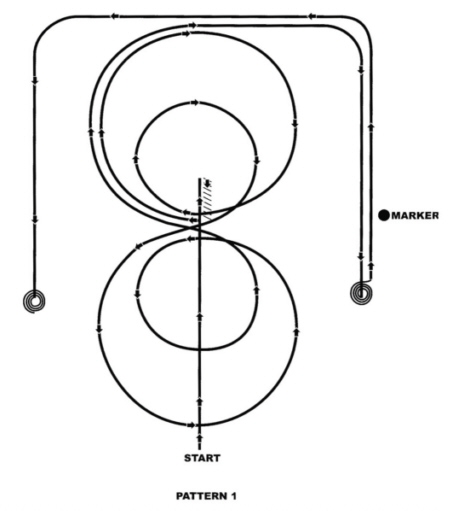
REINED COWHORSE PATTERN I:
1. Start at end of arena. Run down middle past center marker to a sliding stop.
2. Back at least 10 feet to center. 1/4 turn to left.
3. Pick up right lead, large fast circle, small slow circle.
4. Change leads to left, large fast circle, small slow circle.
5. Change leads to right, do not close this circle.
6. Run around end of arena and down the side (approximately 20 feet from fence) past center marker and come to a sliding stop.
7. Complete 3 1/2 spins to the right.
8. Continue back down side and end of arena to other side (approximately 20 feet from fence) go past center marker and come to a sliding stop.
9. Complete 3 1/2 spins to the left.
10. Hesitate to complete pattern.
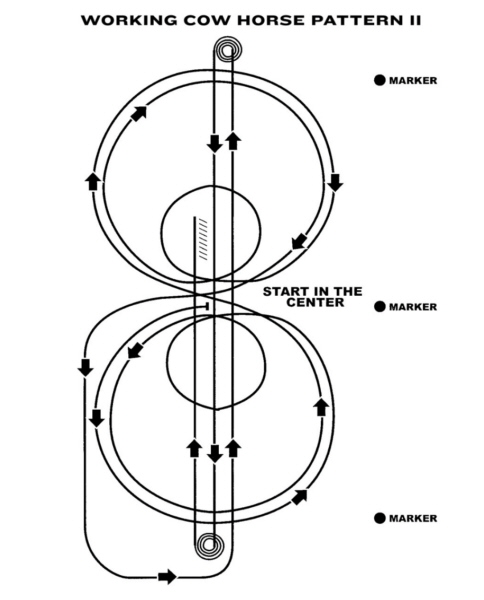
REINED COWHORSE PATTERN II:
Left Lead Start Mandatory
Marker Along Fence or Wall
Trot to center of arena and stop. Start pattern facing toward judge.
1. Pick up left lead, complete three circles to the left. The first one large and fast, the second small and slow, the third large and fast.
2. Change leads at center of arena.
3. Complete three circles to the right. The first one large and fast, the second small and slow, the third large and fast.
4. Change leads at center of arena.
5. Do not stop, continue on to run downs.
6. Run to far end past the marker to a sliding stop. Hesitate.
7. Complete 3 1/2 spins to the left. Hesitate.
8. Run to far end past the marker to a sliding stop. Hesitate.
9. Complete 3 1/2 spins to the right. Hesitate.
10. Run past center marker to a sliding stop. Hesitate.
11. Back at least 10 feet in a straight line. Hesitate.
12. Hesitate to complete pattern.
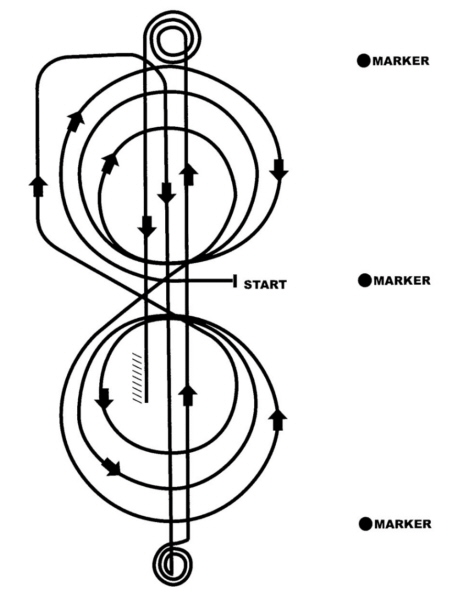
REINED COWHORSE PATTERN III:
Mandatory Marker Along Fence or Wall
Trot to center of arena and stop. Start pattern facing toward judge.
1. Begin on right lead and complete three circles to right, two large fast circles followed by one small slow circle, change to left lead.
2. Complete three circles to left, two large, fast circles followed by one small slow circle. Change to right lead.
3. Continue loping around end of arena without breaking gait.
4. Run up center of arena to far end past the end marker and come to a sliding stop.
5. Complete 2 1/2 spins to the right.
6. Run up center of arena past the end marker, come to a sliding stop.
7. Complete 2 1/2 spins to the left.
8. Run back to middle of the arena past the center marker and come to a sliding stop.
9. Back at least 10 feet in a straight line.
10. Hesitate to complete pattern.

REINED COWHORSE PATTERN IV:
1. Start at end of arena.
2. Run up center of arena past the end marker and come to a sliding stop. Complete 2 1/2 spins to the left.
3. Run to other end of arena past the end marker and stop. Complete 2 1/2 spins to the right.
4. Run past the center marker and stop.
5. Back at least 10 feet in a straight line.
6. Complete 1/4 turn to the left, hesitate. Begin on right lead. Circle to the right. Complete two circles to the right, the first one small and slow and the second large and fast. Change leads at the center of the arena.
7. Complete one small, slow circle and one large, fast circle. Change leads to the right.
8. Run around end of arena to the other side, past the center marker, at least 20 feet from fence and come to a sliding stop.
9. Hesitate to complete pattern.

REINED COWHORSE PATTERN V:
This pattern works best when the exhibitor and cattle enter from the same end of arena.
1. Start at end of arena.
2. Run past the center marker and stop.
3. Back up at least 10 feet.
4. Complete 1/4 turn to the left.
5. Complete 2 circles to the left, the first one large and fast and the second small and slow. Change leads at the center of the arena.
6. Complete two circles to the right, the first one small and slow, the second large and fast. Change leads at the center of the arena.
7. Continue around end of arena without breaking gait or changing leads, run down center of arena past end marker, come to a square sliding stop.
8. Complete 3 1/2 spins to the right.
9. Run down center of arena past end marker and come to a square sliding stop.
10. Complete 3 1/2 spins to the left.
11. Hesitate to complete pattern.
Extra Credit Should Be Given If:
(1) Split reins are used, the rein should fall on the same side as the rein hand.
(2) A romal rein is used; romal should fall on the opposite side from the rein hand (romal is usually held in the rider’s other hand.
(3) Entry Number is shown on saddle blanket or on rider’s back.
(4) Shifty, smooth and having its feet under it at all times when stopping, hind feet should be well under it.
(5) A soft mouth and should respond to a light rein, especially when turning.
(6) Head should be maintained in its natural position.
(7) Work at reasonable speed and still be under control of the rider.
Points Should be Deducted If…
(1) Exaggerated opening of mouth.
(2) Hard or heavy mouth.
(3) Nervous throwing of head.
(4) Lugging on bridle.
(5) Halting or hesitation while being shown, particularly when being run out, indicating anticipation of being set up.
(6) Losing a cow or being unable to finish a pattern because of a bad cow, the contestant should be penalized at the judge’s discretion.
Required Tack:
A western stock saddle without tapaderos. The saddle can have either squared or rounded skirts with the current style leaning toward squared. With or without the rear cinch, sometimes adding “tabs” to occupy the rear girth slots; however, if a rear cinch is used, it must have a connecter strap to the front cinch. Breastplates are optional. Silver should not be counted over a good working outfit. A saddle pad resting under all pressure points is recommended but not required equipment. A western style bridle (browband, one ear, two ear, with or without throatlatch) with a curb bit including a curb strap or curb chain. Standard snaffle bit and bosal hackamores are permitted on horses 4 and under (5 and under for Arabians and Appaloosas). Although the most advanced levels of the Reined Cowhorse event require the use of Romal reins, either Romal reins or split reins are both legal.
Prohibited Tack:
Nosebands or cavessons, any type of martingale or tiedown, tapaderos, roping reins, crops or whips, mechanical hackamores are also prohibited. Split reins may not be knotted or attached to each other (stick wax is of course permitted in model horses) Rider may not have more than one finger between split reins or any fingers between the reins of a rein and romal.
Rider:
Attire is jeans, trousers or pants over western boots, long sleeved shirts, (vest, tie and jacket are also permitted) belt through loop, and western hat. Chaps are optional. The doll rider’s posture must be addressed because if you can’t get it correctly then don’t use it. Doll must sit down in the saddle, the back should be straight. There should be a straight vertical line between the rider’s ear, the elbow and the heel. The knee and toe of the boot should also be in a straight line, knees and feet turned straight along the side of the horse and heel of boot pointed down. The rein arm upper arm should be tucked into the side of the rider, elbow is bent and the forearm parallel to the ground. The free arm is held free and straight down with palm flat and lightly touching the leg. You may place ONE finger between your split reins and there is no rule as to which one – though most riders place their index finger between. If using romal reins the romal hand is carried with hand holding romal at the length of which the romal is straight and not curved. Hackamore or snaffle reins the riders hands should be carried near the pommel and not further than four inches (to scale) out on either side of the saddle horn. Rein hand wrist(s) of either rein is turned slightly inward.
Rein Hand Holds:
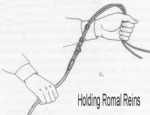

Rein Pull:
Horses are shown on a reasonable loose rein. Extremes such as too tight or too loose should be penalized.



Set-Up Options:
Arena Fencing Required (Indoor or Outdoor Arena)
Types of Fencing Allowed:
- Painted or Natural
- Post and Rail
- Post and Plank
- Chain Link
- Solid Plyboard
- Plyboard with Top Rail
- Post with Drape Rope
- Stock Tube Pipe Rail
- Interior Arena Wall
Footing Required:
- Dirt
- Sand
- No grass base
- No rock base
Backboard or Natural Setting (Indoor or Outdoor)
Examples of Reined Cow Horse Entries:
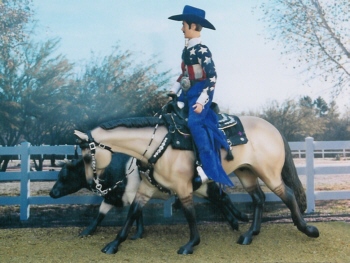
Photo Credit:
Reined Cow Horse – Cow Work – Fence Work
Mom’s Mink Coat – Showing entry performing cow work on the fence. Photo taken by Cynthia Jameson. Model now owned by Betty Thatcher.

Photo Credit:
Reined Cow Horse – Cow Work – Fence Work
Legendary shown as a 3 y/o bay Appaloosa gelding and is a CM BHR Slider by Jameson. Shown by Joanna Richardson with a comment line: Junior Horse: ‘After a reasonable amount of time, the contestant shall take the cow down the fence, making at least one turn (shown here) each way on the fence’.
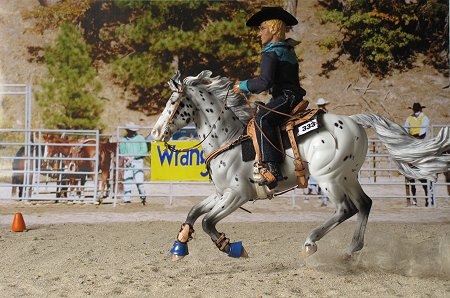
Photo Credit:
Reined Cow Horse – Reined Work
Leopard Rock shown as a Black Semi-leopard Appaloosa Sport Horse (Hanoverian x Appaloosa) gelding is a CM Breyer Show Jumping Warm blood – Ideal. Shown by Andrea Robbins with the Comment: REINED COW HORSE: REINED WORK — ENTRY DEPICTS: NRCHA, REINED WORK, PATTERN 3 STEP 6: which states: Run up center of the arena past the end marker, come to a sliding stop. — ENTRY is running up the center of the arena, approaching the end marker. Entry is competing in a TWO REIN class (using split reins with a curb) for any age horse that has not shown in bridle down the fence.
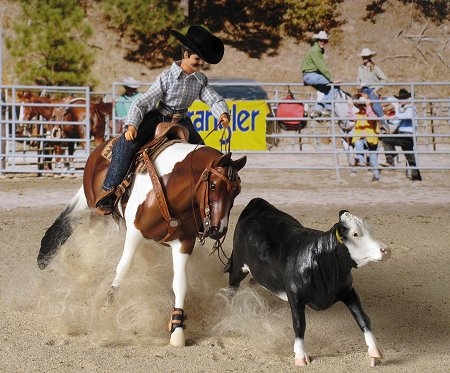
Photo Credit:
Reined Cow Horse – Cow Work – Circle the Cow
Ruggedly Handsome Hawk shown as a bay tobiano Paint stallion and is a Breyer Rugged Painted Lark. Shown by Andrea Robbins with the Comment: COW WORK (Two-rein level) CIRCLE THE COW. ENTRY DEPICTS: Having completed the Herd Work and Reined Work and the first two portions of the Cow Work, the horse and rider are circling the cow in the center of the arena. Entry is competing in a TWO REIN class (using split reins with a curb) for any age horse that has not shown in bridle down the fence.

Photo Credit:
Reined Cow Horse – Cow Work – Fence Work
Apparition shown as a dappled gray Hanoverian mare and is a CM Breyer Show jumper by Donahue. Shown by Andrea Robbins with the comment line: ENTRY DEPICTS: Having completed the Herd Work and Reined Work, and the first step of Cow Work, the horse and rider are turning the cow along the fence. Entry is competing in a Bridle class (using the required ROMAL REINS) for advanced riders.
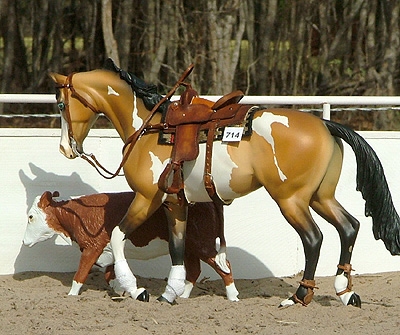
Photo Credit:
Reined Cow Horse – Cow Work – Box or Hold Work
A Classical Zip shown as an Overo Sporthorse Gelding is a CM PS Thoroughbred. Shown by Veronica Geddie. Comment line should read: A Classical Zip shown as an Overo Sporthorse Gelding is a CM PS Thoroughbred. Shown by Veronica Geddie. Comment line should read: As part of the Cow Work portion of Reined Cow Horse, Zip holds or “boxes” the cow at the end of a “Squared” arena to show control of the cow.
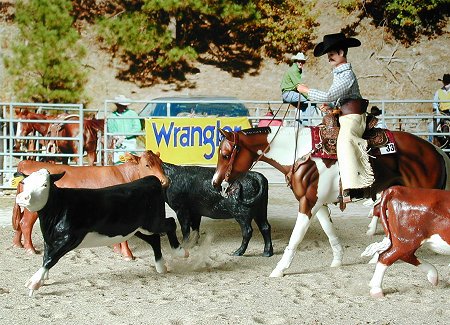
Photo Credit:
Reined Cow Horse – Herd Work
Ruggedly Handsome Hawk shown as a bay tobiano Paint stallion and is a Breyer Rugged Painted Lark. shown by Andrea Robbins with the Comment: Having entered the herd to make a deep cut, the rider urges the horse into a jog to push the selected cow toward the center of the arena where they will work the cow. The rider may rein his horse as needed to make the selection.
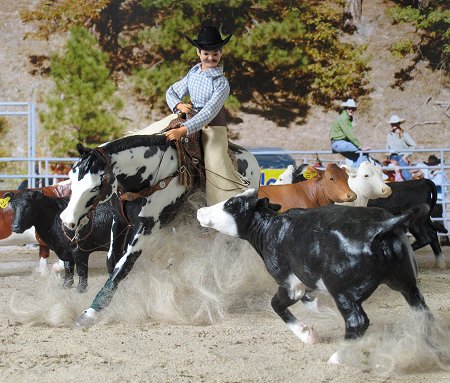
Photo Credit:
Reined Cow Horse – Herd Work
Adrenna Lynn shown as black Overo Paint Mare is a Smokin Hotchick painted by Sherry Clayton. Owned and shown by Andrea Robbins with the Comment: Working the bald-faced cow in the center of the arena. The rider holds the horn. The rider’s rein hand is dropped to allow the horse to work the cow without input from the rider.
Hold the Reins Correctly:
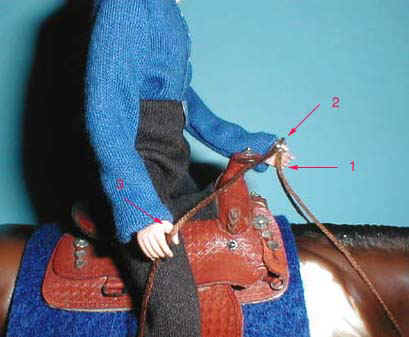
Photo Credit:
Romal Reins by Susan Hargrove
Romal reins enter the hand by the “little” finger lay across the palm of the hand and exit the hand on top over the thumb. The hand holds the reins and not the loop and knot that form the junction of the reins and the romal whip.
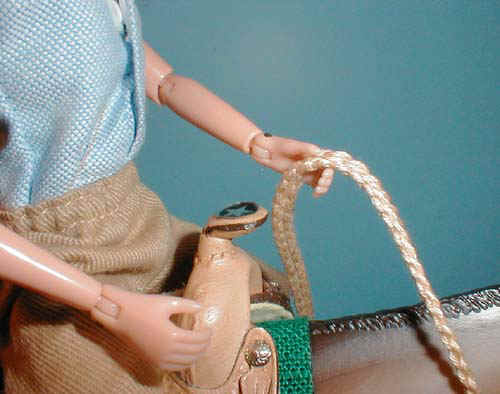
Photo Credit:
Split Reins by Susan Hargrove
Split reins can be held in the right or left hand. The excess rein hang over untouched on the same side of the horse. So if right hand hold the rein then the excess rein lies on the right side of the horse. If left hand holds the rein then the excess rein lies on the left side of the horse. Split reins enter the hand via coming straight into the hand over the index finger and they exit by the little finger.

Photo Credit:
Snaffle Reins by Susan Hargrove
The snaffle rein crosses over the horse’s neck with the bight extending down ward on the opposite side of the horse’s neck. Both hands are used on the reins by picking the rein and the bight up with the palms of the hands facing down.
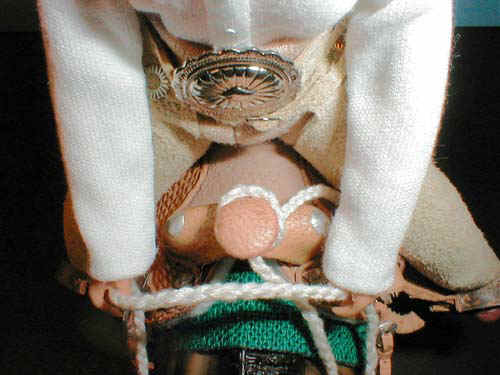
Photo Credit:
Hackamore Mecate Reins by Susan Hargrove
The hackamore mecate rein is a solid single loop rein with the bight tied from the bosal to either the saddle horn or coiled and tied to the front piggin string (or swell string) of the saddle. Both hands are used on the rein by picking the rein with the palms of the hands facing down.
